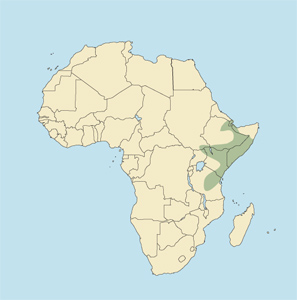 |
Tragelaphus imberbis
Pequeño kudu (Sp), Kleiner Kudu (G), Petit koudou (F). Imberbis alludes to its lack of a beard as compared to a greater kudu.
DESCRIPTION Shoulder height 38-41 inches (96-104 cm). Weight 175-220 pounds (80-100 kg).
The lesser kudu is a graceful, slender, medium-sized antelope with long, spiraling horns. It has a straight back, large ears and a bushy tail. It is grayish brown in color (becoming bluish gray in older animals), with 11-13 well-defined white stripes on each side, an incomplete white chevron between the eyes, and white patches on throat and neck. Its short, brown mane continues as a white dorsal crest. Only the males have horns, and these are keeled, with 2-3 close spirals, and diverge only moderately. The female is slightly smaller, without horns, and is a rufus tan in color.
BEHAVIOR Lives singly, in pairs, or in small family groups. Adult males associate with females only when breeding. A single calf is born after a gestation period of about seven months. Not territorial.
Largely nocturnal, feeding during late evening and early morning and hiding by day in cover. Mainly a browser of leaves and twigs. Grazes occasionally. Drinks daily when available, but can go long periods without water. Hearing and sense of smell are very good, eyesight is fair. A better runner than the greater kudu, and a good jumper. Shy and alert.
HABITAT Semi-arid country with thick bush. Can live in much drier habitat than the greater kudu.
DISTRIBUTION Southeastern Sudan; southern and eastern Ethiopia; Somalia; the Karamoja region of northeastern Uganda; Kenya; and central and northeastern Tanzania.
REMARKS A very fine game animal that is not found in all collections. More difficult to hunt than the greater kudu.
TAXONOMIC NOTES Two subspecies are listed, with boundaries unclear: australis (Kenya and Tanzania) and imberbis (Ethiopia and Somalia). We combine them, with imberbis Blyth, 1869 having priority.
|





